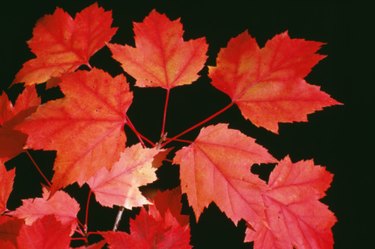
Prized by gardeners and landscape designers, both the red maple and Autumn Blaze maple become medium-sized shade trees that display intensely red fall foliage. Conflicting information exists in print and online publications as to the genetic identity of the Autumn Blaze maple. The only consistent point among them is that red maple genes exist in the Autumn Blaze cultivar.
Origins
Video of the Day
The red maple (Acer rubrum) is native to most of the eastern United States and extreme southeastern Canada. The red maple naturally hybridizes with the native silver maple (Acer saccharinum). Autumn Blaze is a trademark name assigned to red maple tree cultivar Jeffersred. Patented in 1982, this tree was listed with the U.S. Patent and Trademark Office as a seedling of red maple with special features. It was chosen out of many field seedlings growing in Fostoria, Ohio, around 1968 by Glenn C. Jeffers. However, the Missouri Botanical Garden and American woody plant expert Michael Dirr consider Autumn Blaze a hybrid of red maple with silver maple (Acer x freemanii).
Video of the Day
Growth Characteristics
Red maples display a wide range of characteristics, most notably size, habit and degree of leaf retention and leaf shape. A red maple may mature 40 to 60 feet tall and possess a variable canopy width anywhere from 15 to 60 feet wide. The canopy may look irregular or nearly perfectly oval. Moreover, red maples tolerate varying degrees of cold. Trees native to the Southern U.S. are not temperature hardy when transplanted to the Northern U.S. and vice versa. The Autumn Blaze maple consistently matures 40 to 55 feet tall and 30 to 40 feet wide. Its canopy includes many upward-angled branches that create a broadly oval silhouette. Autumn Blaze also grows much faster than a common red maple, a feature that lends merit to it carrying genes from the fast-growing silver maple.
Features
Red maple trees bear lots of deep-red flowers in late winter or very early spring. Pollinated by wind or foraging bees, the blossoms develop into many paired seeds with wings called samaras. The leaves emerge later and become three-lobed, sometimes with two small lobes that make it look five-lobed. In autumn the leaves change to mottled yellow and orange to deep tones of bright to dark red. By contrast, the Autumn Blaze maple only sparsely flowers and sets seeds. The leaves are more five-lobed, and the fall foliage color reliably turns bright scarlet or crimson red.
Growing Considerations
Both red maple and Autumn Blaze maple prosper in similar growing conditions. For best plant form, growth rate and fall foliage coloration, plant the trees in a fertile, moist, acidic to neutral pH soil in full sun. Both trees demonstrate some drought tolerance as well as the ability to survive in soggy or briefly flooded ground. The main difference in growth between the two trees is that a seed-grown red maple tree develops into an unknown plant regarding size, form and ability to produce fine fall color. The Autumn Blaze maple is propagated asexually through cuttings so its characteristics are always known.
- U.S. Patent and Trademark Office; Jeffers Red Maple
- Learn2Grow: Acer Rubrum Jeffersred (Autumn Blaze)
- University of Connecticut Plant Database: Acer Rubrum
- Missouri Botanical Garden: Acer x Freemanii Jeffersred Autumn Blaze
- U.S. Forest Service; Red Maple; Russell S. Walters and Harry W. Yawney
- U.S. Forest Service; Silver Maple; William J. Gabriel
- National Gardening Association: USDA Hardiness Zone Finder